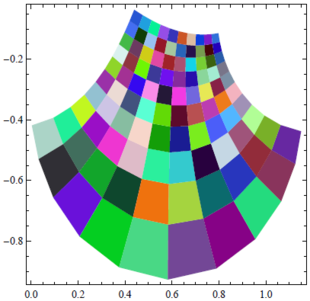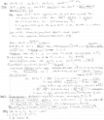12-240/Classnotes for Tuesday September 18
| |||||||||||||||||||||||||||||||||||||||||||||||||||||||||
Various properties of fields
Thrm 1: In a field F: 1. a+b = c+b ⇒ a=c
2. b≠0, a∙b=c∙b ⇒ a=c
3. 0 is unique.
4. 1 is unique.
5. -a is unique.
6. a^-1 is unique (a≠0)
7. -(-a)=a
8. (a^-1)^-1 =a
9. a∙0=0 **Surprisingly difficult, required distributivity.
10. ∄ 0^-1, aka, ∄ b∈F s.t 0∙b=1
11. (-a)∙(-b)=a∙b
12. a∙b=0 iff a=0 or b=0
. . .
16. (a+b)∙(a-b)= a^2 - b^2 [Define a^2 = a∙a] Hint: Use distributive law
Thrm 2: Given a field F, there exists a map Ɩ: Z → F with the properties (∀ m,n ∈ Z):
1) Ɩ(0) =0, Ɩ(1)=1
2) Ɩ(m+n) = Ɩ(m) +Ɩ(n)
3) Ɩ(mn) = Ɩ(m)∙Ɩ(n)
Furthermore, Ɩ is unique.
Rough proof:
Test somes cases:
Ɩ(2) = Ɩ(1+1) = Ɩ(1) + Ɩ(1) = 1 + 1 ≠ 2
Ɩ(3) = Ɩ(2 +1)= Ɩ(2) + Ɩ(1) = 1+ 1+ 1 ≠ 3
. . .
Ɩ(n) = 1 + ... + 1 (n times)
Ɩ(-3) = ?
Ɩ(-3 + 3) = Ɩ(-3) + Ɩ(3) ⇒ Ɩ(-3) = -Ɩ(3) = -(1+1+1)
What about uniqueness? Simply put, we had not choice in the definition of Ɩ. All followed from the given properties.
At this point, we will be lazy and simply denote Ɩ(3) = 3_f [3 with subscript f]
∃ m≠0, m ∈ N, Ɩ(m) =0
In which case, there is a smallest m<0, for which Ɩ(m)=0. 'm' is the characteristic of F. Denoted char(F). Examples: char(F_2)=2, char(F_3)=3... but NOTE: char(R)=0
Thrm: If F is a field and char(F) >0, then char(F) is a prime number.




